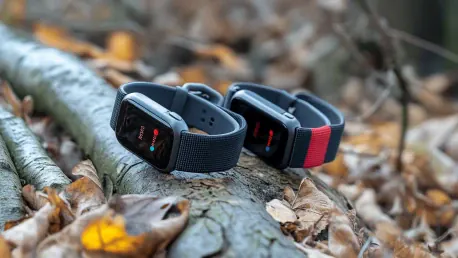When it comes to choosing the perfect fitness tracker, the decision often boils down to a few critical factors: accuracy, features, and price. In this article, we pit two popular fitness trackers against each other—the Fitbit Sense 2 and the Amazfit Active 2—to see which one stands out in a head-to-head comparison. Tested around Seattle’s Lake Washington, these devices were evaluated on multiple metrics including step count, distance, elevation gain, heart rate, and battery usage.
Design and Features
Aesthetics and Build Quality
Both the Fitbit Sense 2 and Amazfit Active 2 boast sleek designs and lightweight builds, making them comfortable for all-day wear. Their bright and responsive touchscreens ensure ease of use, and both devices feature physical buttons for additional control. The sense of premium design is palpable with both devices, as their aesthetics seamlessly blend into casual and fitness-focused lifestyles. The Fitbit Sense 2 embodies a modern, minimalist design with rounded edges and a thin profile, which fits snugly on the wrist without feeling cumbersome. On the other hand, the Amazfit Active 2, while stylish, exudes a more rugged charm suitable for those who prefer a sportier look.
Despite the affordable price tag of the Amazfit Active 2 at $99 compared to the $249 Fitbit Sense 2, there’s no compromise on build quality. Users will appreciate that both trackers come with comfortable, durable straps suitable for diverse activities, from intense workouts to everyday wear. In terms of durability, both are solid contenders, with the Fitbit Sense 2 offering a more polished finish and the Amazfit Active 2 leaning towards robustness. It’s a matter of personal preference whether users lean towards the sophisticated finish of the Sense 2 or the all-terrain stability of the Amazfit Active 2.
Core Capabilities
Each tracker comes equipped with onboard GPS and a suite of wellness and fitness tracking technologies. These include metrics like step count, distance, elevation, heart rate, and calories burned. Moreover, both devices are compatible with iPhones and Android devices, offering smart features such as notifications and app integrations. The Fitbit Sense 2 and Amazfit Active 2 not only tally physical exertions but also monitor general wellness, including sleep patterns, stress levels, and other health metrics.
The onboard GPS in both devices allows for accurate tracking of outdoor activities without needing to carry a smartphone. Additionally, the touch interface and physical buttons make navigation intuitive, whether users are mid-run or casually browsing through daily stats. However, it’s the integration with their respective apps that truly enhances user experience. Fitbit’s app is renowned for its user-friendly interface and extensive community features, providing a comprehensive overview of one’s fitness journey. Meanwhile, the Amazfit app complements its device by offering rich insights and customization, making fitness tracking a personalized experience.
Accuracy of Metrics
Step Count
In the walk test, the Fitbit Sense 2 recorded 6,187 steps, while the Amazfit Active 2 logged 6,116 steps. Both exceeded the manual count of 6,000 steps, with the Fitbit overestimating by 187 steps and the Amazfit by 116 steps. Strava, used as a control, recorded 6,046 steps, showing better accuracy than both smartwatches. It’s intriguing that despite their similar functionalities, the step counting precision varied, indicating nuanced differences in their algorithms.
The slight overestimations by both devices aren’t drastic but do emphasize the importance of understanding individual tracker behaviors. For fitness enthusiasts who demand precision, knowing the typical margin of error is valuable for interpreting daily metrics. Users may need to manually calibrate or account for a slight margin when planning workouts or when steps are critical for fitness goals. A prime takeaway here is the consistency of the slight overestimation, as it’s a recurrent theme with many fitness trackers across the market. Accuracy, although paramount, often presents itself within a reasonable range rather than pinpoint precision.
Distance and Elevation
For distance, the Amazfit Active 2 was closer to Strava’s measurement with 3.16 miles, compared to Fitbit Sense 2’s 2.82 miles. Elevation gain data showed Fitbit Sense 2 closely matched Strava’s 297 feet with a reading of 280 feet, while Amazfit Active 2 overestimated at 368 feet. The disparities between the devices in distance and elevation gains indicate that while both trackers are competitive, their internal calculations differ, impacting their readings.
An insightful observation from these results is that the Amazfit Active 2 seems to excel in step and distance tracking, possibly due to more aggressive calibration targeting outdoor activity enthusiasts. On the flip side, Fitbit’s performance in elevation gain aligns more accurately with control measurements, offering users a reliable gauge for vertical movements. These distinctions are quintessential for different types of users; trekkers might lean towards the Amazfit for better distance metrics, while hikers and those needing precise elevation data could favor the Fitbit. Fitness trackers are evolving to cater to niche preferences, and these performance insights guide users towards a choice that aligns with their specific activity profiles.
Heart Rate and Battery Performance
Heart Rate Monitoring
The Fitbit Sense 2 recorded an average heart rate of 116 bpm and a maximum of 164 bpm, aligning more closely with control data from previous tests. The Amazfit Active 2, however, reported lower readings with an average of 101 bpm and a maximum of 136 bpm, raising questions about its accuracy. Accurate heart rate monitoring is crucial, particularly for users who rely on precise data to fine-tune their training intensities or monitor cardiovascular health.
While the variance in heart rate readings might seem minor, it holds significant implications for athletes and health-conscious users. Fitness tracking technologies depend on reliable heart rate data for insights into overall exertion, calorie burn, and recovery. The consensus from comparative tests suggests that Fitbit’s heart monitoring technology is more fine-tuned to deliver consistency and accuracy. This reliability is especially vital during high-intensity sessions where heart rate zones guide the effectiveness and safety of the workout. Thus, users needing absolute confidence in their heart metrics might tilt towards the Fitbit Sense 2, given its close alignment with control references.
Battery Usage
Battery efficiency is a crucial aspect for any fitness tracker. During the walk, the Amazfit Active 2 showed superior efficiency by depleting 0% of its battery, whereas the Fitbit Sense 2 used up 2%. This is particularly noteworthy given the high battery consumption typically associated with onboard GPS. The practical implications of battery performance extend beyond single activities to overall user experience and convenience.
A robust battery is not just a luxury but a necessity for those who engage in long-duration workouts or outdoor adventures where charging facilities aren’t readily available. Amazfit Active 2’s battery efficiency aligns well with the demands of intensive tracking without frequent recharge cycles, providing reliability and uninterrupted performance. On the other hand, Fitbit Sense 2’s marginally higher battery consumption isn’t a dealbreaker but highlights an area where continuous improvement can bolster user satisfaction. Ultimate preference hinges on the balance users seek between precise tracking and prolonged battery life, making Amazfit’s battery longevity a compelling factor for endurance athletes and outdoor enthusiasts.
User Preferences
Prioritizing Metrics
Choosing between the Fitbit Sense 2 and Amazfit Active 2 ultimately depends on what metrics and features are most important to the user. The Fitbit Sense 2 excels in heart rate and elevation data accuracy, while the Amazfit Active 2 offers better step count accuracy and battery efficiency. The variance in data underscores that user needs dictate the best choice between the two. For individuals whose primary focus is cardiovascular health and training, the Fitbit provides comprehensive and precise data sets vital to fine-tuning fitness regimens.
Conversely, for those who are more concerned with day-to-day step counts and the longevity of their device, the Amazfit Active 2 presents a strong argument. It’s not just about the raw numbers but contextualizing these features within personal fitness journeys. Even within the realm of fitness enthusiasts, there are varying needs ranging from casual walkers aiming for daily step goals to athletes monitoring intricate performance metrics. Understanding these nuanced differences helps users make informed decisions tailored to their lifestyles and fitness priorities.
Price Considerations
Choosing the right fitness tracker can be challenging, as critical factors like accuracy, features, and price weigh heavily in the decision-making process. In this article, we compare two popular fitness trackers—the Fitbit Sense 2 and the Amazfit Active 2—to determine which one excels in a head-to-head evaluation. Both devices were rigorously tested around Seattle’s scenic Lake Washington, focusing on multiple metrics such as step count, distance, elevation gain, heart rate, and battery usage. The Fitbit Sense 2 offers comprehensive health monitoring and smart features, making it a well-rounded choice. On the other hand, the Amazfit Active 2 is known for its budget-friendly price while still delivering robust performance and essential fitness tracking capabilities. By comparing the two, you can see how they stack up against each other in real-world conditions, helping you make an informed decision about which tracker best fits your fitness needs and lifestyle.









